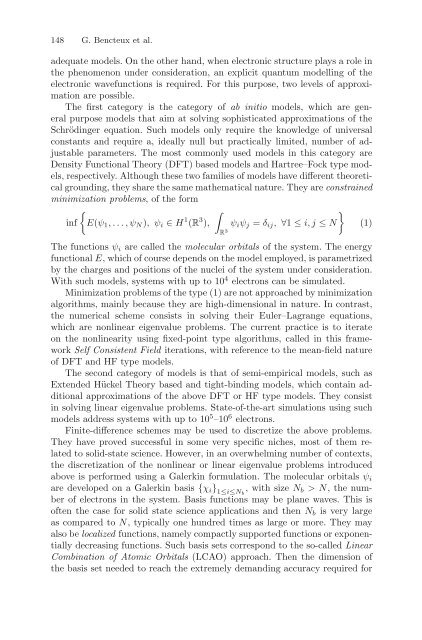Partial Differential Equations - Modelling and ... - ResearchGate
Partial Differential Equations - Modelling and ... - ResearchGate
Partial Differential Equations - Modelling and ... - ResearchGate
Create successful ePaper yourself
Turn your PDF publications into a flip-book with our unique Google optimized e-Paper software.
148 G. Bencteux et al.<br />
adequate models. On the other h<strong>and</strong>, when electronic structure plays a role in<br />
the phenomenon under consideration, an explicit quantum modelling of the<br />
electronic wavefunctions is required. For this purpose, two levels of approximation<br />
are possible.<br />
The first category is the category of ab initio models, which are general<br />
purpose models that aim at solving sophisticated approximations of the<br />
Schrödinger equation. Such models only require the knowledge of universal<br />
constants <strong>and</strong> require a, ideally null but practically limited, number of adjustable<br />
parameters. The most commonly used models in this category are<br />
Density Functional Theory (DFT) based models <strong>and</strong> Hartree–Fock type models,<br />
respectively. Although these two families of models have different theoretical<br />
grounding, they share the same mathematical nature. They are constrained<br />
minimization problems, oftheform<br />
{<br />
∫<br />
}<br />
inf E(ψ 1 ,...,ψ N ), ψ i ∈ H 1 (R 3 ), ψ i ψ j = δ ij , ∀1 ≤ i, j ≤ N (1)<br />
R 3<br />
The functions ψ i are called the molecular orbitals of the system. The energy<br />
functional E, which of course depends on the model employed, is parametrized<br />
by the charges <strong>and</strong> positions of the nuclei of the system under consideration.<br />
With such models, systems with up to 10 4 electrons can be simulated.<br />
Minimization problems of the type (1) are not approached by minimization<br />
algorithms, mainly because they are high-dimensional in nature. In contrast,<br />
the numerical scheme consists in solving their Euler–Lagrange equations,<br />
which are nonlinear eigenvalue problems. The current practice is to iterate<br />
on the nonlinearity using fixed-point type algorithms, called in this framework<br />
Self Consistent Field iterations, with reference to the mean-field nature<br />
of DFT <strong>and</strong> HF type models.<br />
The second category of models is that of semi-empirical models, such as<br />
Extended Hückel Theory based <strong>and</strong> tight-binding models, which contain additional<br />
approximations of the above DFT or HF type models. They consist<br />
in solving linear eigenvalue problems. State-of-the-art simulations using such<br />
models address systems with up to 10 5 –10 6 electrons.<br />
Finite-difference schemes may be used to discretize the above problems.<br />
They have proved successful in some very specific niches, most of them related<br />
to solid-state science. However, in an overwhelming number of contexts,<br />
the discretization of the nonlinear or linear eigenvalue problems introduced<br />
above is performed using a Galerkin formulation. The molecular orbitals ψ i<br />
are developed on a Galerkin basis {χ i } 1≤i≤Nb<br />
, with size N b >N,thenumber<br />
of electrons in the system. Basis functions may be plane waves. This is<br />
often the case for solid state science applications <strong>and</strong> then N b is very large<br />
as compared to N, typically one hundred times as large or more. They may<br />
also be localized functions, namely compactly supported functions or exponentially<br />
decreasing functions. Such basis sets correspond to the so-called Linear<br />
Combination of Atomic Orbitals (LCAO) approach. Then the dimension of<br />
the basis set needed to reach the extremely dem<strong>and</strong>ing accuracy required for
















